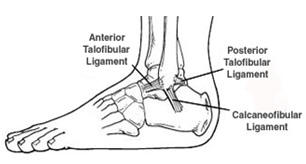ANKLE SPRAINS
ANKLE SPRAIN AND TREATMENTS
Ankle sprains are common injuries that occur when ligaments are stretched or torn. The ankle sprain is the most common athletic injury. Nearly 85% of ankle sprains occur laterally, or on the outside of ankle joints. Sprains on the inside ligaments are less common. Many sprains occur when participating in sports, or by twisting the ankle when walking on an uneven surface. Some individuals, due to their bone structure or foot type, are more prone to ankle sprains.
ANATOMY OF THE ANKLE JOINT
The ankle joint is made up of three bones. The bones are called
the tibia, fibula, and talus. These bones form a socket in which
the ankle joint moves.
The tibia, fibula and talus are connected to each other by
ligaments. Think of ligaments as thick rubber bands that hold
bones together so that joints are stable and function properly.
When an ankle is sprained, a ligament is stretched, partially
torn or completely torn. Muscle and tendon structures surround
the ligaments. These structures provide motion of the ankle
joint for walking and running. Blood vessels, nerves and skin
overlie the ligaments and tendons. The ankle joint moves the
foot upward and downward. Just below the ankle joint is a ball
and socket type joint that allows inward and outward motion.
ANKLE INJURY SYMPTOMS
Ankle sprain symptoms vary depending on severity. Often, the ankle Is tender, swollen and discolored. The ankle can be quite painful to touch. Walking is usually hampered and may become difficult depending on the severity of the sprain. A feeling of instability may occur, especially in severe ankle sprains when ligaments are torn. Ankle sprains are classified by "types" and range from mild to moderate to severe. Classifying ankle sprains helps the podiatric surgeon diagnose the specific structures involved in the injury. This also helps determine appropriate treatment plans for each type of ankle sprain. Type I ankle sprain, the least severe, occurs when ligament fibers have been stretched or slightly torn. Type II sprain occurs when some of these fibers or ligaments are completely torn. Type III, the most severe, occurs when the entire ligament is torn and there is significant instability of the ankle joint. Fractures of the ankle bone or outside the foot bone may be present. Fractures require immediate diagnosis and attention for appropriate treatment.
DIAGNOSIS
The podiatric surgeon examines the ankle to identify the type of ankle sprain and determine the appropriate method of treatment. X-rays or specialized X-ray views of the ankle and foot may also be used to reveal any fractures, dislocations or instability of the ankle joint. Less frequently, more sophisticated testing is necessary to examine soft tissue injuries. For example, computerized tomography (CT) and magnetic resonance imaging (MRI) give detailed views of the bone and soft tissue structures around the ankle joint. Once the diagnosis is made, the podiatric surgeon recommends appropriate therapy.
TREATMENTS
Initial treatment includes rest, ice, compression and elevation
(RICE). The "RICE" method promotes healing, decreases pain, and
reduces swelling around the ankle joint. In more severe cases,
non-weight bearing activities are encouraged and crutches may be
recommended. Compression may be achieved with an elastic
bandage, splint, short leg cast or brace, depending on severity.
Compression eliminates motion around the ankle joint. The
ability to walk or participate in other weight bearing
activities during the healing process depends on the severity or
type of ankle sprain. This is determined by the podiatric
surgeon once the diagnosis is made. Most ankle sprains heal in
three to eight weeks. In more severe cases, ligaments may
require more healing time to promote ankle stability. Repeated
ankle sprains may cause chronic instability, interfering with
walking or sports activities. In this case, the podiatric
surgeon may recommend a surgical procedure to tighten or create
new ligaments around the ankle joint to re-establish stability
of the ankle joint.
Conservative treatment of many foot and ankle problems often
promotes pain relief. For example, ankle strengthening exercises
following the injury help prevent recurrence of injury. Most of
these exercises can be done at home after appropriate
instruction. Ankle supports and braces or taping around the
ankle joint is especially helpful for individuals participating
in sports. Your podiatric surgeon may recommend preventive
bracing to help prevent future injury
SUMMARY
The adage "it is better to break an ankle than sprain one" need
not apply if the injury is appropriately diagnosed and treated
by the podiatric surgeon. Properly treated, the rehabilitated
ankle can tolerate normal activities and the stress of
participating in sports. The podiatric surgeon is a foot and
ankle specialist who diagnoses foot and ankle conditions and
determines appropriate treatment. While these are some of the
most commonly prescribed treatments for ankle sprains, others
may be used. The podiatric surgeon will determine which
treatment is likely to be the most successful in each case.
© 1994 The American College of Foot and Ankle Surgeons
